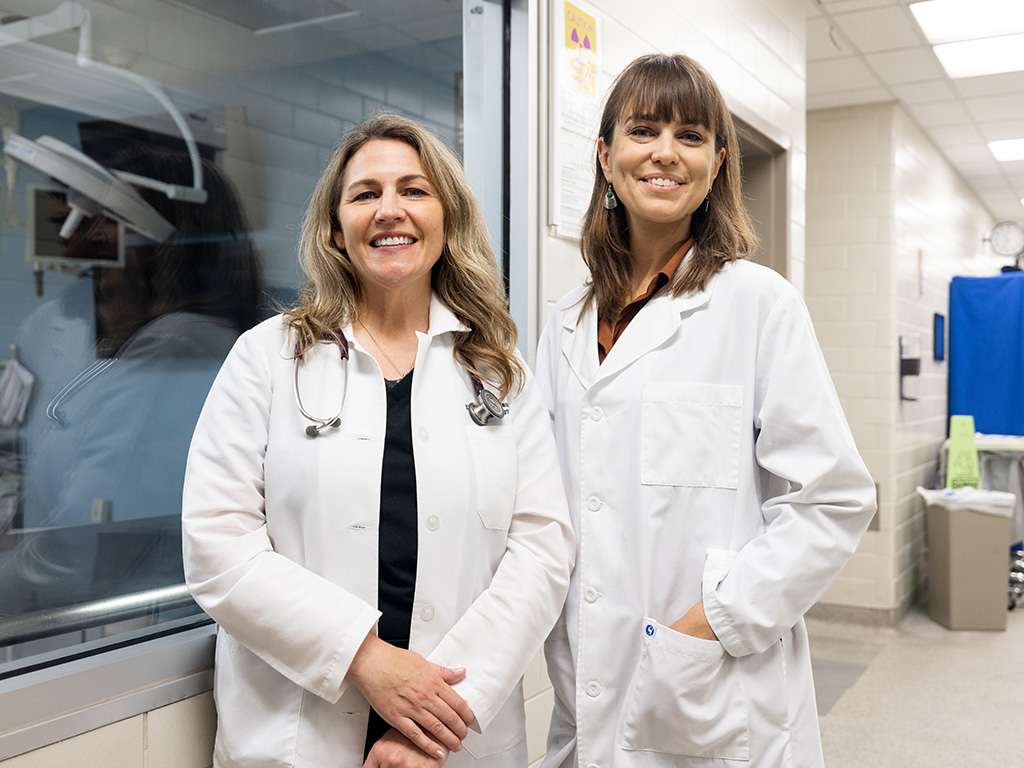Texas A&M Gastrointestinal Laboratory Collaborates With Virologist To Prevent Liver Disease In Cats
Story by Courtney Price, VMBS Marketing & Communications

The Texas A&M Gastrointestinal Laboratory (GI Lab) is partnering with feline virologist Dr. Julia A. Beatty to study viral causes of liver diseases, including cancer, in cats.
Beatty, whose team recently discovered the feline “cousin” of hepatitis B virus, a major cause of liver cancer in humans, is the chair professor of veterinary medicine and infectious diseases at City University of Hong Kong. She is an expert in feline oncoviruses, or viruses that cause cancer, as well as an experienced specialist in feline medicine. Her work has led to significant advances in the field of companion animal infectious diseases.
At Texas A&M, Beatty is collaborating with GI Lab director Dr. Jörg Steiner, a Regents Professor in the College of Veterinary Medicine & Biomedical Sciences’ (VMBS) Department of Small Animal Clinical Sciences, and his team.
“Hepatitis B is a global health problem for humans, but this is the first hepatitis B-related virus to be found in a carnivore — and a companion animal,” Beatty said. “Typically, animal variants of hepatitis-B virus have been investigated for the benefit of humans, but the health of domestic cats is the primary driver for our work.”
For Beatty, working with the GI Lab means partnering with researchers who are just as passionate about feline health as her team is.
“It’s the No. 1 research institute of its kind,” she said. “It’s also a very friendly place that draws collaborators from all over. Bringing all those people together in such a nurturing and positive environment — that’s what makes magic happen.”
Understanding Hepatitis B In Cats
There are several different types of hepatitis in humans, each with varying degrees of severity.
Hepatitis A is most often a food-borne illness that is easy to transmit but causes relatively mild damage to the liver. Hepatitis B, however, spreads through contact with contaminated bodily fluids and from mothers to babies, causing chronic disease and often leading to long-term liver damage, cancer, and cirrhosis.
“The goal of our study is to determine whether the feline hepatitis B-like virus causes disease in cats like it does in humans,” Beatty said. “We have already identified an association between the virus and both chronic hepatitis and hepatocellular carcinoma (HCC), the most common type of liver cancer in cats. In fact, about a quarter of feline HCC cases are positive for the virus. But more work must be done to fully understand how the virus affects cat health.
“These diseases are not incredibly common in cats,” she said. “But it’s possible that chronic hepatitis is more common than we think.”
Interestingly, the same hepatitis B-like virus has been detected in a small number of dogs, but there is no evidence that it causes liver disease in that species.
“There is also no evidence that people could catch this virus, so there’s no cause for concern on that front,” Beatty said. “However, it has been found in some ‘big cat’ species, like the Iberian lynx, which is endangered.”
A Pathway To Treatment
While a vaccine for the hepatitis B virus does not exist for cats, one does already exist for humans; fortunately, this means that future research into a feline vaccine is likely to be easier.
“The hepatitis B vaccine is really safe and effective,” Beatty said. “Really, the main reason that we haven’t yet eradicated human hepatitis B virus is the logistics of getting the vaccine into people.”
“If we identify that we need to develop treatments and a vaccine for cats, there will still be a lot of work to do,” she said. “The type of drugs that are used in humans for hepatitis B are actually quite toxic for cats, but there are already some new virus treatments that can point researchers in the right direction. There’s already a lot of knowledge in this area.”
This research collaboration was made possible through Texas A&M’s Hagler Institute for Advanced Study, which annually supports collaborations between top researchers from around the world and established teams at Texas A&M.
###
For more information about the Texas A&M College of Veterinary Medicine & Biomedical Sciences, please visit our website at vetmed.tamu.edu or join us on Facebook, Instagram, and Twitter.
Contact Information: Jennifer Gauntt, Director of VMBS Communications, Texas A&M College of Veterinary Medicine & Biomedical Sciences, jgauntt@cvm.tamu.edu, 979-862-4216
You May Also Like








